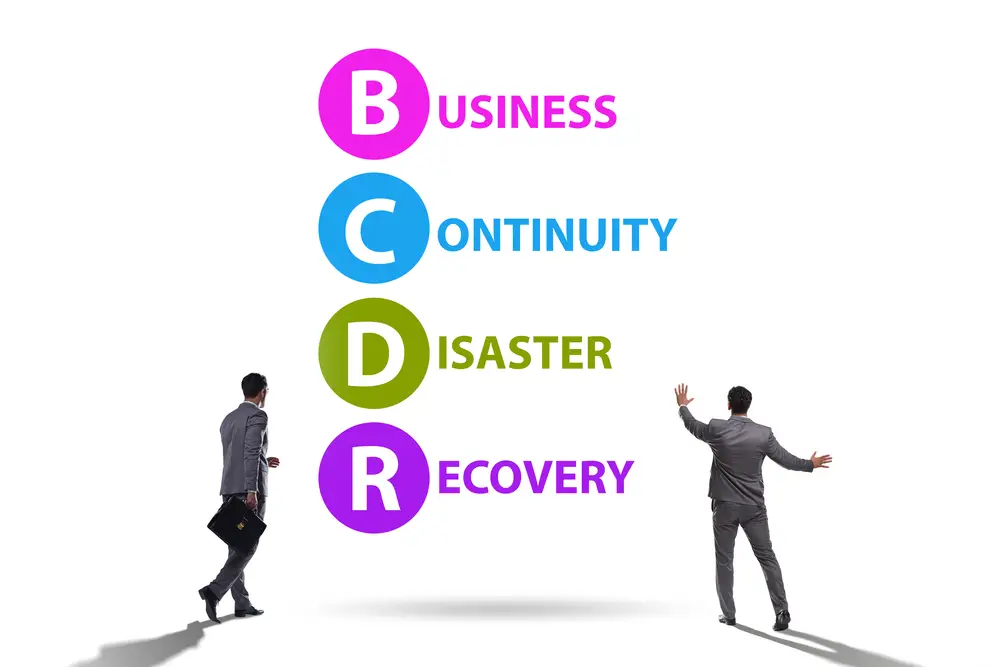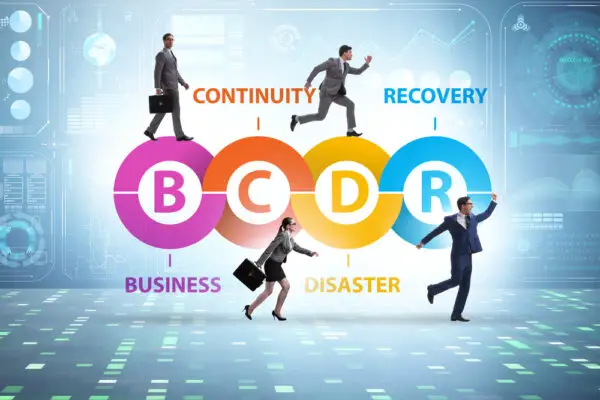Business continuity, disaster recovery, and incident response plans are essential for any organization to ensure the safety of its operations and data. Business continuity and disaster recovery plans focus or (BCPs) provide a framework for maintaining operations during or after a significant disruption or incident.
Disaster recovery plans (DRPs) focus on restoring data access and IT infrastructure after a disaster. Incident response plans (IRPs) guide teams through recovery when a cyberattack or data breach first occurs. Understanding the differences between these three types of plans is important to create an effective strategy for responding to incidents.
Many professionals are comfortable with rhythm and routine and assume their working environment will remain relatively unchanged. But sometimes, something happens that disrupts normal business. One of the critical aspects of leadership is to prepare for interruptions and develop a strategy and plan for response procedures to ensure the integrity and stability of core business functions.
Two specific areas were addressed: potential: business continuity focuses and interruption: business continuity & recovery. This discipline minimizes the impacts of catastrophic events on the business’s ability to deliver its products consistently.
As a business owner or manager, you must be prepared for whatever life throws your way. To do this, you must have an effective disaster plan. However, you should be aware of three main types of plans: a business continuity strategy, disaster recovery, and incident response.
In this blog post, we will go over the key differences between business continuity, and disaster recovery strategies, and incident response plans to help you understand which ones your organization needs for optimal protection.
From understanding their objectives to exploring their various components, you’ll have a better idea at the end of our discussion about how each plan works best in helping your company mitigate risks effectively and respond quickly.
Business Continuity Plans
A business continuity plan is designed to help keep your business running during times of crisis. It focuses on preventing and preparing for disasters, such as natural disasters or economic downturns, that could affect your bottom line.
A business continuity plan outlines how your company will respond if it experiences an emergency or disruption in operations.
This includes steps such as identifying critical functions and processes that must be maintained during an event, developing alternative strategies in case those processes fail, and establishing communication channels with employees and other stakeholders to ensure everyone is informed about the situation.
Disaster Recovery Plans
A disaster recovery plan is designed to help you recover quickly from any disaster or emergency affecting your business operations. It involves creating a comprehensive strategy for restoring systems, equipment, data, and other resources following a disruptive event such as a power outage or computer virus attack.
The goal is to minimize downtime and financial losses by quickly returning to full operation as soon as possible after the incident has occurred that’s how incident response vs business continuity works.
Incident Response Plans
An incident response and communication plan is designed to help you respond quickly and effectively when a security breach occurs on your network or within your organization’s computing environment.
It outlines specific steps that should be taken by IT staff members in order to contain the attack and mitigate the potential damage caused by malicious actors or hackers who are attempting to gain access to sensitive information within your system.
An incident response plan also details procedures for gathering evidence related to the attack so that it can be used in criminal proceedings against those responsible for it.
Creating a business continuity plan
The first step in creating a business continuity plan is to conduct a business impact analysis. This will help identify time-sensitive or critical business functions and processes and the resources that support them.
Once these have been identified, creating protocols and systems for prevention incident response teams and recovery is important. This includes identifying key personnel who are responsible for executing the plan, developing procedures for restoring operations after an incident, and establishing communication plans with stakeholders.
Finally, it’s important to regularly review and update your business continuity plan so that it remains up-to-date with changes in technology and regulations. Doing so will help ensure that your organization is prepared for any potential disruptions in service.
Make sure all disruptions are planned and rethink worst-case scenarios. You should review your emergency plans regularly. The best plan for backup can be outlined. Plan A & C cannot be used. Alternatives.
Several potential contributors are worth considering, as these are numerous. Make it a priority. While preparation is important for every event, it is also important for a flexible strategy that allows rapid adjustments in situations that change.
Excessive situations can involve minute changes in shift time. That is a major reason for the plan to require continuous monitoring.
Emergency Management Director
Emergency Management Directors design and execute business plans for natural disasters and emergency response. The ability to analyze problems, solve delegations and communicate is critical.
A survey conducted by the Bureau of Labor Statistics in 2018 estimated emergency managers’ annual salaries to be $74,590 annually.
An Emergency Management Director is responsible for coordinating disaster response or crisis management activities. This includes ordering evacuations, opening public shelters, and implementing special needs plans. They also design emergency response plans and procedures to respond to emergencies such as natural disasters.
Additionally, they keep informed of activities or changes that could affect the likelihood of an emergency, response efforts, or plan implementation.
Emergency Management Directors must be prepared to lead the response in times of crisis and ensure that all necessary steps are taken to protect people and property from harm. They must have excellent communication skills in order to coordinate with other agencies and organizations during a disaster.
Furthermore, they must be able to think quickly on their feet and make decisions in high-pressure situations.
If you’re interested in becoming an Emergency Management Director, you’ll need at least a bachelor’s degree in emergency management or a related field, such as public administration or public health.
You may also need additional certifications depending on the state you live in. Additionally, experience working in emergency services or related fields can give you an edge when applying for jobs.
The risks of not having business continuity and disaster recovery plans
organizations risk losing critical data, suffering financial losses due to downtime, damaging their reputation, and facing legal consequences. Additionally, without these plans, organisations may be unable to access important resources or personnel during a disruption. This can cause further delays in restoring operations and increase the risk management financial losses associated with the disruption.
Organizations must take proactive steps to create comprehensive business continuity and disaster recovery plans that address all potential risks they may face during a disruption. Taking the time now to create these plans will help protect organizations from costly disruptions in the future.
Having not been prepared can cause significant problems for a business.
How is business continuity planning different from disaster recovery planning?
A Continuity Plan is a plan that outlines what operations are able to perform during an emergency. During disaster recovery plans, applications are restored and their functionality can resume.
BCP is a comprehensive plan that outlines how a company can mitigate the loss of essential business operations and define the steps needed to maintain or quickly resume critical functions during an emergency. It focuses on strategies to keep essential business functions running, from supply and delivery chains to human resources and operations.
On the other hand, DRP is more focused on the tools and solutions needed to restore affected technology and data after a disaster has occurred. It dictates how a business should respond to a disaster, with the main goal being to restore IT systems as quickly as possible.
BCP is concerned with preventing damage, while DRP is concerned with recovering from it.
What is the difference between BCM and DR?
BCM, or business continuity management, describes a company’s ability to provide continuous delivery of goods and services in a disaster. The term disaster recovery generally refers to the recovery process from a disaster that has taken place in the industry.
Conduct a Business Impact Analysis (BIA)
Your business could be at risk when you are looking for an accurate report on BIA risks. Once identified, the researcher should conduct further investigation. When talking about situations causing the loss or modification of services or functions, you will want the entire team involved. Write out any problems that you face and their possible effect.
The BIA process begins by identifying the essential business functions and processes for the organization’s survival. This includes identifying the resources needed to support these functions business processes, such as personnel, technology, facilities, and materials.
Once these have been identified, it is important to analyze each function in detail in order to identify any potential risks or vulnerabilities that could disrupt operations. This includes looking at external factors such as economic conditions, competition, or regulatory changes that could affect the organization’s ability to operate effectively.
Once all potential risks have been identified, assessing their impact on the organization’s operations is important. This includes determining how long it would take for operations to be restored after a disruption occurs and what steps need to be taken in order for this restoration process to occur quickly and efficiently.
Additionally, it is important to consider any financial implications associated with a disruption to determine how much money would be lost if operations were disrupted for an extended period.
Finally, once all of this information has been gathered and analyzed, it is important for organizations to develop strategies for mitigating any risks that have been identified through the BIA process.
These strategies should include short-term solutions, such as contingency plans or backup systems, and long-term solutions, such as proactive strategies such as investing in new technologies or improving existing processes.
Conclusion
Depending on the size of your business and its needs, all three types of plans—business continuity plans, disaster recovery plans, and incident response plans—are essential components of an effective disaster preparedness program.
They guide how best to respond if something goes wrong so that you can protect yourself and your customers from harm while minimizing any disruption in service or financial losses caused by an emergency event.

Chris Ekai is a Risk Management expert with over 10 years of experience in the field. He has a Master’s(MSc) degree in Risk Management from University of Portsmouth and is a CPA and Finance professional. He currently works as a Content Manager at Risk Publishing, writing about Enterprise Risk Management, Business Continuity Management and Project Management.




